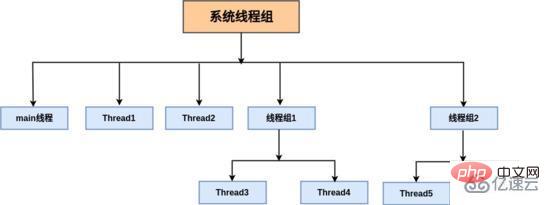Java中使用线程组的示例和方法介绍
Java中线程组(ThreadGroup类)
Java中使用ThreadGroup类来代表线程组,表示一组线程的集合,可以对一批线程和线程组进行管理。可以把线程归属到某一个线程组中,线程组中可以有线程对象,也可以有线程组,组中还可以有线程,这样的组织结构有点类似于树的形式,如图所示。

用户创建的所有线程都属于指定线程组,如果没有显式指定属于哪个线程组,那么该线程就属于默认线程组(即main线程组)。默认情况下,子线程和父线程处于同一个线程组。
此外,只有在创建线程时才能指定其所在的线程组,线程运行中途不能改变它所属的线程组,也就是说线程一旦指定所在的线程组就不能改变。
二.为什么要使用线程组
1.安全
同一个线程组的线程是可以相互修改对方的数据的。但如果在不同的线程组中,那么就不能“跨线程组”修改数据,可以从一定程度上保证数据安全。
2.批量管理
可以批量管理线程或线程组对象,有效地对线程或线程组对象进行组织或控制。
三.线程组使用示例
1.线程关联线程组:一级关联
所谓一级关联就是父对象中有子对象,但并不创建孙对象。比如创建一个线程组,然后将创建的线程归属到该组中,从而对这些线程进行有效的管理。代码示例如下:
public class ThreadGroupTest {
public static void main(String[] args) {
ThreadGroup rootThreadGroup = new ThreadGroup("root线程组");
Thread thread0 = new Thread(rootThreadGroup, new MRunnable(), "线程A");
Thread thread1 = new Thread(rootThreadGroup, new MRunnable(), "线程B");
thread0.start();
thread1.start();
}
}
class MRunnable implements Runnable {
@Override
public void run() {
while (!Thread.currentThread().isInterrupted()) {
System.out.println("线程名: " + Thread.currentThread().getName()
+ ", 所在线程组: " + Thread.currentThread().getThreadGroup().getName()) ;
try {
Thread.sleep(1000);
} catch (InterruptedException e) {
e.printStackTrace();
}
}
}
}
复制代码执行结果如下:
线程名: 线程A, 所在线程组: root线程组 线程名: 线程B, 所在线程组: root线程组 复制代码
2.线程关联线程组:多级关联
所谓的多级关联就是父对象中有子对象,子对象中再创建孙对象也就出现了子孙的效果了。比如使用下图第二个构造方法,将子线程组归属到某个线程组,再将创建的线程归属到子线程组,这样就会有线程树的效果了。

代码示例如下:
public class ThreadGroupTest {
public static void main(String[] args) {
ThreadGroup rootThreadGroup = new ThreadGroup("root线程组");
Thread thread0 = new Thread(rootThreadGroup, new MRunnable(), "线程A");
Thread thread1 = new Thread(rootThreadGroup, new MRunnable(), "线程B");
thread0.start();
thread1.start();
ThreadGroup threadGroup1 = new ThreadGroup(rootThreadGroup, "子线程组");
Thread thread2 = new Thread(threadGroup1, new MRunnable(), "线程C");
Thread thread3 = new Thread(threadGroup1, new MRunnable(), "线程D");
thread2.start();
thread3.start();
}
}
class MRunnable implements Runnable {
@Override
public void run() {
while (!Thread.currentThread().isInterrupted()) {
System.out.println("线程名: " + Thread.currentThread().getName()
+ ", 所在线程组: " + Thread.currentThread().getThreadGroup().getName()
+ ", 父线程组: " + Thread.currentThread().getThreadGroup().getParent().getName());
try {
Thread.sleep(1000);
} catch (InterruptedException e) {
e.printStackTrace();
}
}
}
}
复制代码执行结果如下:
线程名: 线程A, 所在线程组: root线程组, 父线程组: main 线程名: 线程B, 所在线程组: root线程组, 父线程组: main 线程名: 线程C, 所在线程组: 子线程组, 父线程组: root线程组 线程名: 线程D, 所在线程组: 子线程组, 父线程组: root线程组 复制代码
3.批量管理组内线程
使用线程组自然是要对线程进行批量管理,比如可以批量中断组内线程,代码示例如下:
public class ThreadGroupTest {
public static void main(String[] args) {
ThreadGroup rootThreadGroup = new ThreadGroup("root线程组");
Thread thread0 = new Thread(rootThreadGroup, new MRunnable(), "线程A");
Thread thread1 = new Thread(rootThreadGroup, new MRunnable(), "线程B");
thread0.start();
thread1.start();
ThreadGroup threadGroup1 = new ThreadGroup(rootThreadGroup, "子线程组");
Thread thread2 = new Thread(threadGroup1, new MRunnable(), "线程C");
Thread thread3 = new Thread(threadGroup1, new MRunnable(), "线程D");
thread2.start();
thread3.start();
rootThreadGroup.interrupt();
System.out.println("批量中断组内线程");
}
}
class MRunnable implements Runnable {
@Override
public void run() {
while (!Thread.currentThread().isInterrupted()) {
System.out.println("线程名: " + Thread.currentThread().getName()
+ ", 所在线程组: " + Thread.currentThread().getThreadGroup().getName()
+ ", 父线程组: " + Thread.currentThread().getThreadGroup().getParent().getName());
try {
Thread.sleep(1000);
} catch (InterruptedException e) {
e.printStackTrace();
break;
}
}
System.out.println(Thread.currentThread().getName() + "执行结束");
}
}
复制代码执行结果如下:
线程名: 线程A, 所在线程组: root线程组, 父线程组: main 线程名: 线程B, 所在线程组: root线程组, 父线程组: main 线程名: 线程C, 所在线程组: 子线程组, 父线程组: root线程组 线程名: 线程D, 所在线程组: 子线程组, 父线程组: root线程组 批量中断组内线程 线程A执行结束 线程B执行结束 线程C执行结束 线程D执行结束 复制代码
以上是Java中使用线程组的示例和方法介绍的详细内容。更多信息请关注PHP中文网其他相关文章!

热AI工具

Undresser.AI Undress
人工智能驱动的应用程序,用于创建逼真的裸体照片

AI Clothes Remover
用于从照片中去除衣服的在线人工智能工具。

Undress AI Tool
免费脱衣服图片

Clothoff.io
AI脱衣机

Video Face Swap
使用我们完全免费的人工智能换脸工具轻松在任何视频中换脸!

热门文章

热工具

记事本++7.3.1
好用且免费的代码编辑器

SublimeText3汉化版
中文版,非常好用

禅工作室 13.0.1
功能强大的PHP集成开发环境

Dreamweaver CS6
视觉化网页开发工具

SublimeText3 Mac版
神级代码编辑软件(SublimeText3)
 突破或从Java 8流返回?
Feb 07, 2025 pm 12:09 PM
突破或从Java 8流返回?
Feb 07, 2025 pm 12:09 PM
Java 8引入了Stream API,提供了一种强大且表达力丰富的处理数据集合的方式。然而,使用Stream时,一个常见问题是:如何从forEach操作中中断或返回? 传统循环允许提前中断或返回,但Stream的forEach方法并不直接支持这种方式。本文将解释原因,并探讨在Stream处理系统中实现提前终止的替代方法。 延伸阅读: Java Stream API改进 理解Stream forEach forEach方法是一个终端操作,它对Stream中的每个元素执行一个操作。它的设计意图是处
 PHP:网络开发的关键语言
Apr 13, 2025 am 12:08 AM
PHP:网络开发的关键语言
Apr 13, 2025 am 12:08 AM
PHP是一种广泛应用于服务器端的脚本语言,特别适合web开发。1.PHP可以嵌入HTML,处理HTTP请求和响应,支持多种数据库。2.PHP用于生成动态网页内容,处理表单数据,访问数据库等,具有强大的社区支持和开源资源。3.PHP是解释型语言,执行过程包括词法分析、语法分析、编译和执行。4.PHP可以与MySQL结合用于用户注册系统等高级应用。5.调试PHP时,可使用error_reporting()和var_dump()等函数。6.优化PHP代码可通过缓存机制、优化数据库查询和使用内置函数。7
 PHP与Python:了解差异
Apr 11, 2025 am 12:15 AM
PHP与Python:了解差异
Apr 11, 2025 am 12:15 AM
PHP和Python各有优势,选择应基于项目需求。1.PHP适合web开发,语法简单,执行效率高。2.Python适用于数据科学和机器学习,语法简洁,库丰富。
 PHP与其他语言:比较
Apr 13, 2025 am 12:19 AM
PHP与其他语言:比较
Apr 13, 2025 am 12:19 AM
PHP适合web开发,特别是在快速开发和处理动态内容方面表现出色,但不擅长数据科学和企业级应用。与Python相比,PHP在web开发中更具优势,但在数据科学领域不如Python;与Java相比,PHP在企业级应用中表现较差,但在web开发中更灵活;与JavaScript相比,PHP在后端开发中更简洁,但在前端开发中不如JavaScript。
 PHP与Python:核心功能
Apr 13, 2025 am 12:16 AM
PHP与Python:核心功能
Apr 13, 2025 am 12:16 AM
PHP和Python各有优势,适合不同场景。1.PHP适用于web开发,提供内置web服务器和丰富函数库。2.Python适合数据科学和机器学习,语法简洁且有强大标准库。选择时应根据项目需求决定。
 Java程序查找胶囊的体积
Feb 07, 2025 am 11:37 AM
Java程序查找胶囊的体积
Feb 07, 2025 am 11:37 AM
胶囊是一种三维几何图形,由一个圆柱体和两端各一个半球体组成。胶囊的体积可以通过将圆柱体的体积和两端半球体的体积相加来计算。本教程将讨论如何使用不同的方法在Java中计算给定胶囊的体积。 胶囊体积公式 胶囊体积的公式如下: 胶囊体积 = 圆柱体体积 两个半球体体积 其中, r: 半球体的半径。 h: 圆柱体的高度(不包括半球体)。 例子 1 输入 半径 = 5 单位 高度 = 10 单位 输出 体积 = 1570.8 立方单位 解释 使用公式计算体积: 体积 = π × r2 × h (4
 PHP的影响:网络开发及以后
Apr 18, 2025 am 12:10 AM
PHP的影响:网络开发及以后
Apr 18, 2025 am 12:10 AM
PHPhassignificantlyimpactedwebdevelopmentandextendsbeyondit.1)ItpowersmajorplatformslikeWordPressandexcelsindatabaseinteractions.2)PHP'sadaptabilityallowsittoscaleforlargeapplicationsusingframeworkslikeLaravel.3)Beyondweb,PHPisusedincommand-linescrip
 PHP:许多网站的基础
Apr 13, 2025 am 12:07 AM
PHP:许多网站的基础
Apr 13, 2025 am 12:07 AM
PHP成为许多网站首选技术栈的原因包括其易用性、强大社区支持和广泛应用。1)易于学习和使用,适合初学者。2)拥有庞大的开发者社区,资源丰富。3)广泛应用于WordPress、Drupal等平台。4)与Web服务器紧密集成,简化开发部署。






